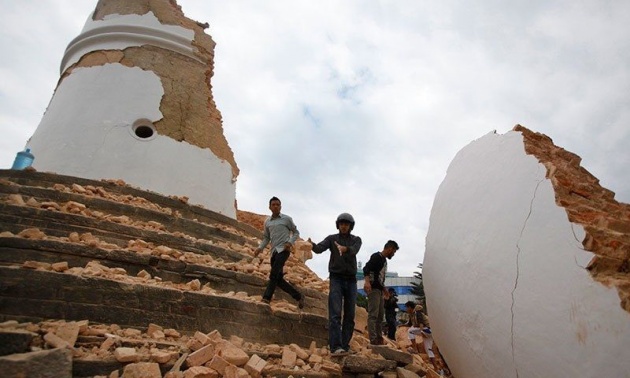
Scores of centuries-old historical monuments, including the iconic Dharahara of Kathmandu, were reduced to rubble in the massive earthquake that hit the country on Saturday afternoon.
The earthquake and the shockwaves that followed throughout the day destroyed around 80 per cent of the temples in Basantapur Durbar Square.
Several temples, including Kasthamandap, Panchtale temple, the nine-storey Basantapur Durbar, the Dasa Avtar temple, Krishna Mandir and two dewals located behind the Shiva Parvati temple, were demolished by the quake.
Kasthamandap, a temple that inspired the name Kathmandu, is an early 16th century wooden monument.
A few other monuments, including the Kumari Temple and the Taleju Bhawani, among others, have partially collapsed.
At Dharahara, around two dozen dead bodies were recovered from the tower’s debris. At least a hundred other people had bought tickets to climb up the tower, but luckily they had not proceeded to climb when the quake hit.
Dharahara had broken into parts in a similar earthquake that occurred around 83 years ago.
Similarly, dozens of temples and historical buildings in Patan and Bhaktapur have collapsed or been partially damaged.
The top of the Jay Bageshwori Temple in Gaushala and some parts of the Pashupatinath Temple, Swyambhunath, Boudhanath Stupa, Ratna Mandir, inside Rani Pokhari, and Durbar High School have been partially destroyed.
In Patan, the Char Narayan Mandir, Yog Narendra Malla’s statue, a pati inside Patan Durbar Square, the Taleju Temple, the Hari Shanker and Uma Maheshwor Temple and the Machhindranath Temple in Bungmati were destroyed.
Several bodies, including those of women and children, were recovered from the remains of the collapsed monuments.
Rescue teams said that at least 70 dead bodies were recovered from the debris of the Dharahara, and even more bodies from the remains of the temples in Durbar Square.
The Durbar Square is one of the most popular tourist hotspots in Kathmandu, both for foreign and domestic tourists.
It is also a favoured hangout place for locals. On Saturdays, more people, mainly children and students, visit the square than on other days of the week.
In Tripureshwor, the Kal Mochan Ghat, a Mughal-architecture inspired temple, was completely destroyed and the nearby Tripura Sundari also suffered significant damage.
In Bhaktapur, several monuments, including the Fasi Deva temple, the Chardham temple and the 17th century Vatsala Durga Temple, were fully or partially destroyed.
Outside the Valley, the Manakamana Temple in Gorkha, the Gorkha Durbar, the Palanchowk Bhagwati, in Kavrepalanchowk, the Rani Mahal in Palpa, the Janaki Mandir in Janakpur, the Churiyamai in Makwanpur, the Dolakha Bhimsensthan in Dolakha, and the Nuwakot Durbar were partially destroyed.
Prushottam Lochan Shrestha, a historian, said these monuments could be lost forever, as rebuilding them is technically difficult and expensive.
“We have lost most of the monuments that had been designated as World Heritage Sites in Kathmandu, Bhaktapur and Lalitpur.
They cannot be restored to their original states,” said Shrestha.



